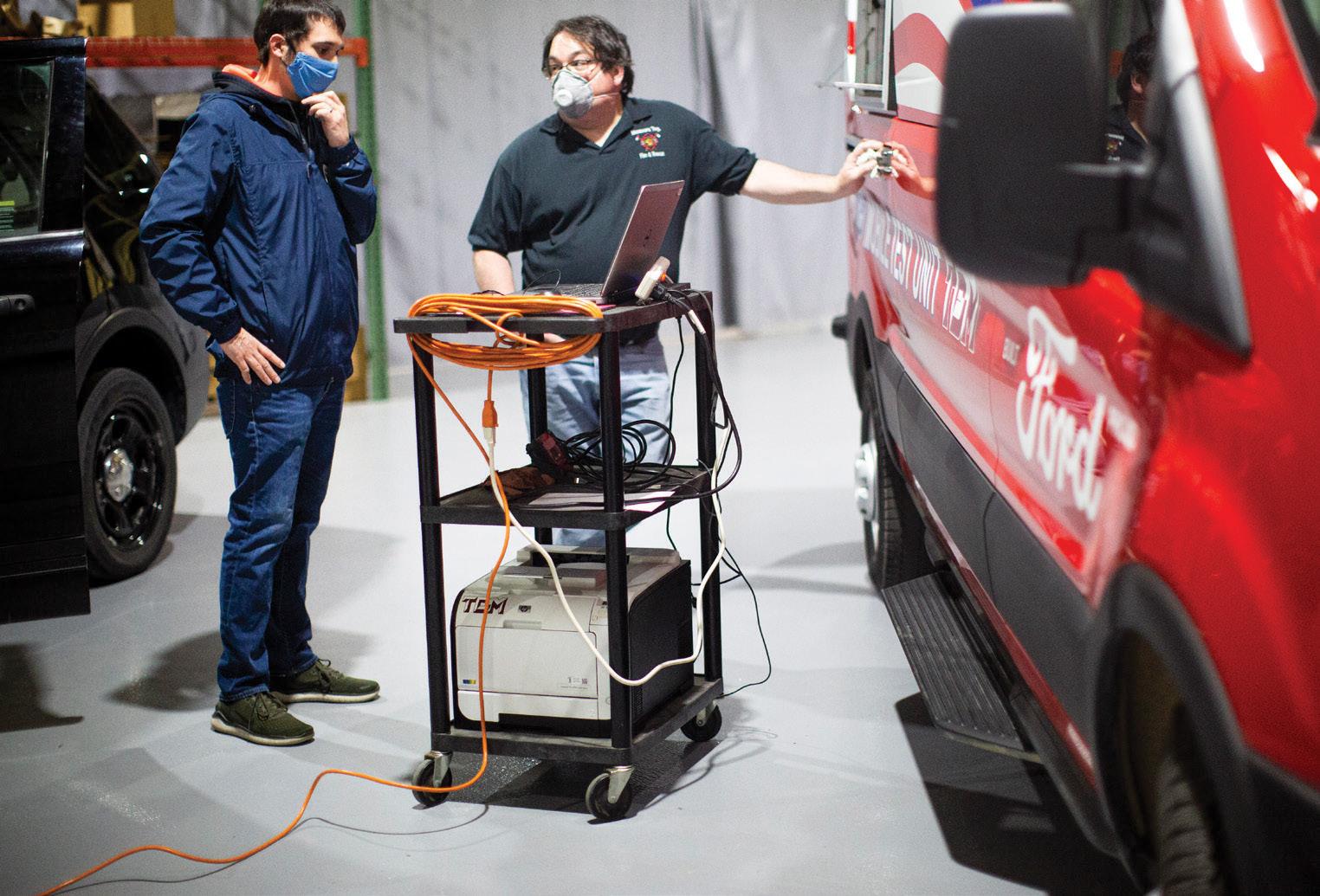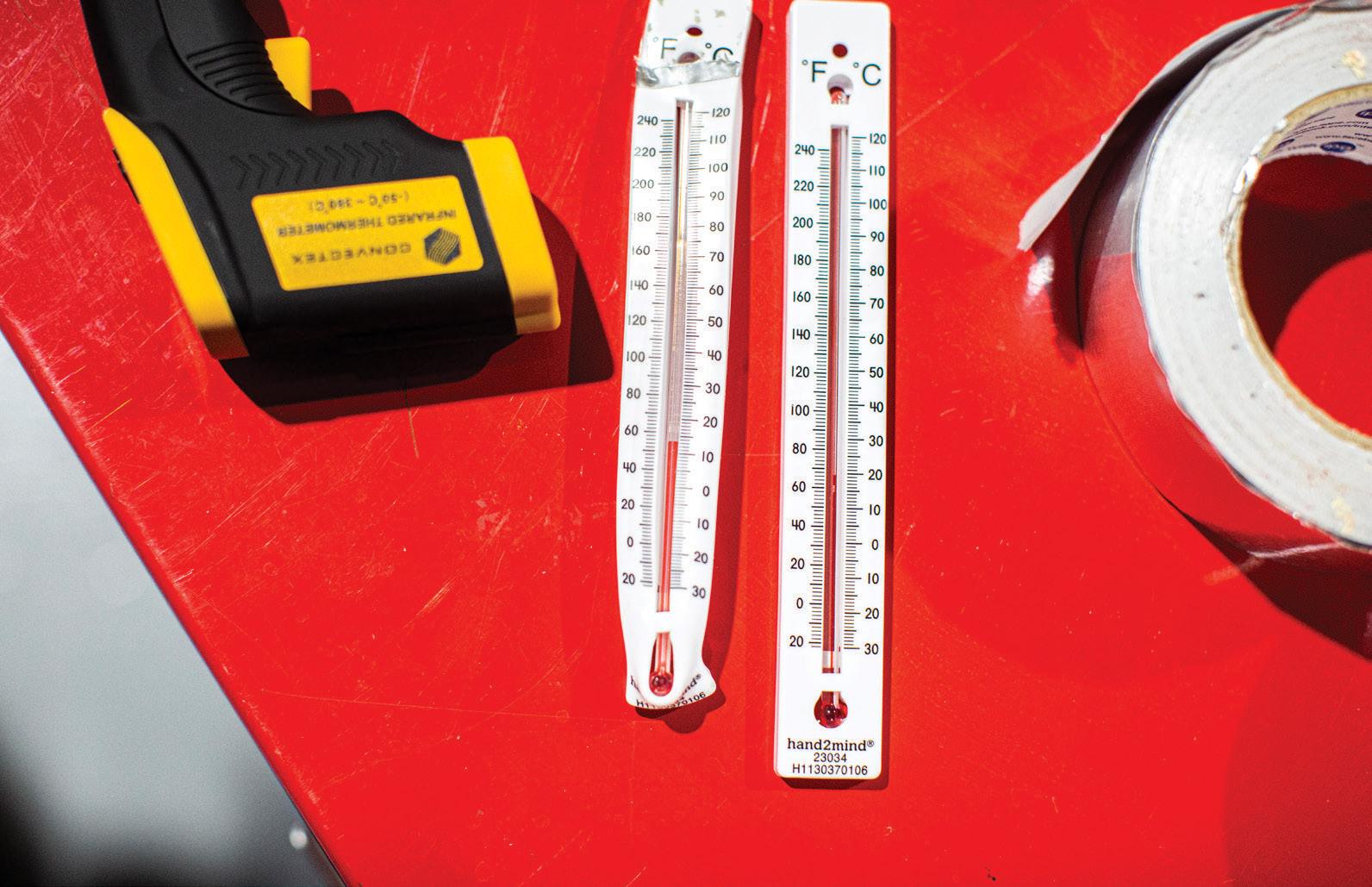
11 minute read
FORD’S LATEST TECH HELPS
PACKING HEAT: HOW FORD’S HOW FORD’S LATEST TECH HELPS POLICE VEHICLES NEUTRALIZE COVID-19



BY BRAD BREWER

WWW.MEDIA.FORD.COM



The COVID-19 pandemic has changed the world forever and with that change comes new innovations to help all of us overcome and adapt to our new world. As the leader in the Police vehicle market, Ford has stepped up in numerous ways to assist our rst responders with a multitude of new innovations. Ford factories were some of the rst to engineer and produce PPE equipment and also life-saving ventilators.
Ford is not a company that waits for innovation; they are the creators of new innovation and especially in their Police vehicle program. As the rst to engineer and design the safety feature called “Surveillance Mode,” which they also made available to other vehicle manufacturers and the military, Ford has always been determined to make their products the safest possible vehicles available to Public Safety. e new version of Surveillance Mode is now the much-improved factory-installed “ Police Perimeter Alert.” It uses BLIS ® (Blind Spot Information System) sensors for approximately 270-degree monitoring outside of the vehicle and analyzes the motion to determine if a behavior is a potential threat. It features a visual display in the instrument panel cluster that shows moving objects, the motion trail, and therefore the possible threat level. When potentially threatening behavior is detected, it also will sound a chime, activate the Rear View Camera, and automatically roll up the windows and lock the doors.
When COVID-19 hit, Ford stepped up again with two engineers who had an idea on how to disinfect Police vehicles using external portable heaters by placing them in the vehicles. is idea looked prom-



ising, but the logistics of moving the equipment around was determined to be cumbersome and likely not well received by large eet customers. So the question the engineers had to answer was, “How do we use existing invehicle hardware and software to create an environment inside the vehicle suitable to neutralize coronavirus quickly and e ciently?” At the same time Ford was looking at this idea, the New York City Police Department (NYPD) was actively looking for the same solution with their existing eet. NYPD has a very large eet of Police vehicles and as New York became the epicenter for COVID-19, the shortage of ambulances essentially turned every police vehicle into a COVID-19 patient transport vehicle. at in itself became a signi cant problem, because how do you reuse a vehicle that just transported a COVID-19 patient?
NYPD tried many of the suggested chemical solution cleaning processes like many other Police agencies, but chemicals are harsh on people and vehicles, and there is no way to foresee the long-term e ects of all those chemicals. How do you know if the vehicle is actually disinfected? Actually you do not, because no matter how hard someone tries, there are some areas that are going to be missed. e Ford engineering team initiated a project in late March to de-contaminate vehicles using heat. Shortly after, a discussion with the NYPD alerted Ford to its need for a more e cient disinfecting process during the pandemic. is immediate demand from NYPD pushed the engineering team even harder to nd a feasible solution, because now there was a clear need to move fast. e solution that the engineering team came up with is



nothing short of remarkable when you think about the complexity of the challenge faced by the engineers and the time frame in which they solved it. is idea was developed and launched in six to eight weeks, stunning when you really grasp the depth of the issue. Ford commissioned e Ohio State University to test surface samples located inside the vehicle, providing veri cation that heat beyond 133 degrees Fahrenheit applied to these surfaces for 15 minutes will help reduce the viral concentration inside the vehicle by more than 99 percent. is COVID-19 neutralization solution turned out to be a new heated software enhancement for its Police Interceptor Utility and one that law enforcement





agencies across the country can utilize to help reduce the footprint of the COVID19 virus. e actual software solution uses the vehicle’s existing powertrain and climate control systems to temporarily raises interior temperatures beyond 133 degrees Fahrenheit (hotter than Death Valley on the hottest day) for 15 minutes to help reduce the viral concentration inside the vehicle by greater than 99 percent.
Ford worked with The Ohio State University to determine the temperature range and time needed to help reduce the spread of the COVID-19 virus. Additionally, Ford conducted software operational trials with vehicles owned by the New York City Police Department, Los Ange-



les Police Department, and others. is latest example of smart vehicle technology, this software solution is available immediately on all 2013-19 Police Interceptor Utility vehicles in the United States, Canada, and other countries around the world.
“First responders are on the front lines protecting all of us. ey are exposed to the virus and are in dire need of protective measures,” said Hau ai-Tang, Ford chief product development and purchasing o cer. “We looked at what is in our arsenal and how we could step up to help.



In this case, we have turned the vehicle’s powertrain and heat control systems into a virus neutralizer.”
So how exactly does this unique software/ hardware solution work, you ask?
Once activated, the vehicle’s powertrain and climate control systems work together automatically to elevate passenger compartment temperatures. e software warms up the engine to an elevated level, and both heat and fan settings operate on high. e software automatically monitors interior temperatures until the entire passenger compartment hits the optimal level, then that temperature is maintained for 15 minutes.
“Our studies with Ford Motor Company indicate that exposing coronaviruses to temperatures of 56 degrees Celsius, or 132.8 degrees Fahrenheit, for 15 minutes reduces the viral concentration by greater than 99 percent on interior surfaces and materials used inside Police Interceptor Utility vehicles,” said Je Jahnes and Jesse Kwiek, laboratory supervisors at e Ohio State University department of microbiology.
Agencies and Fleet Managers will have multiple ways to monitor progress of this solution as it is being applied to each vehicle. Hazard lights and taillights will ash in a pre-set pattern to notify when the process has begun, then will change at the end to signal completion. e vehicle’s instrument cluster will also indicate progress. A cooldown process brings the temperature down from its highest points.
is heated process can be used by law enforcement regularly to help sanitize vehicles when o cers are not inside. When used in conjunction with sanitization guidelines approved by the Centers for Disease Control and Prevention (CDC), ooding the passenger compartment with elevated air temperature can help reach areas that may be missed by manual disinfecting procedures.
Heat has the ability to seep into crevices and hard-to-reach areas, helping reduce the impact of human error in applying chemical disinfectants.
Ford conducted software operational trials in vehicles owned by the New York City Police Department, Los Angeles Police Department, Michigan State Police, Massachusetts State Police, Boardman Township

Police Department in Ohio, and Seminole County Sheri ’s O ce in Florida.
One of the key agencies that was involved early in the development of this process was Boardman Township Police Department in Ohio. Fleet Manager Michael Carkido, a member of Ford’s Police Advisory Board, assisted engineers in the development. Carkido is a strong proponent of this sanitation process.
“ We see Ford’s recommended way to help battle COVID along with other germs, viruses, and bedbugs a great asset to our eet of 30 PIUs. Plugging my portable MyCANIC tool into the vehicle’s OBD port allows me to perform the heat sanitizing as a preventative maintenance or when a cruiser might be or is infected. I believe ooding the interior with extreme high heat gets in all those hard-to-reach areas and is much better than any chemical. e brilliant minds at Ford police engineering have given us another great tool to protect the protectors.”
“Law enforcement officers are being dispatched as emergency responders in some cases where ambulances may not be available,” said Stephen Tyler, Ford police brand marketing manager. “During one trip, o cers may be transporting a coronavirus patient to a hospital, while another trip may involve an occupant who may be asymptomatic.” is solution when used in conjunction with sanitization guidelines approved by the CDC can safely heat the passenger compartment to help ensure vehicles are properly disinfected before being deployed again.




“O cers can now use this self-cleaning mode as an extra layer of protection inside the vehicle i n areas where manual cleaning is prone to be overlooked,” Tyler stated. “ is virus is an invisible enemy and we are proud to provide a solution to help the law enforcement community ght it.”
So how does your agency get this solution implemented?
For the initial rollout, the large departments with their own service centers can install the software solution using their own diagnostic service tools, while other eets can work with their local dealers to install the software for 2013-19 Police Interceptor Utility vehicles.
All 2013-2019 Police Interceptor Utility vehicles will need to have the software enhancement activated through an external tool that connects to the onboard diagnostics port.
For 2016-19 Police Interceptor Utility vehicles, the heated software process can then be activated by a smart sequence of commands that involves pressing cruise control buttons in a predefined order. 2013-15 model year vehicles must remain connected to the external tool to activate the heated software solution. An operation guide for these processes can be downloaded as well.
“Vehicles from the 2013 to 2019 model years make up the majority of Police Interceptor Utility vehicles cur-

rently in use by rst responders,” Tyler said. “Delivering this new capability to these vehicles rst allows us to help as many o cers as possible, as quickly as possible.”
In addition to the 2013-2019 Police Interceptor Utility, Ford has also added the heated software solution availability to the 2013-2019 Police Interceptor Sedan. Sedan vehicles equipped with 3.5L Twin Independent Variable Camshaft Timing (TiVCT), 3.5L TiVCT, or 3.5L EcoBoost engine have a new IDS service function

tool that activates a heating procedure – when combined with Centers for the CDC guidelines – helps reduce virus counts inside the interior of Police Interceptor and Police Interceptor Sedan vehicles. Agencies should follow the Service Procedure steps to perform the virus reduction procedure, which can be found when downloading the IDS enhancement or through their local dealer.
Ford will continue working on ways to bring this software capability to additional Ford Police vehicles in 2020, so stay tuned for more updates on additional vehicles being covered by this impressive engineering solution that shows not only does Ford lead the market with new and innovative vehicles, but in the face of adversity, Ford can rise to the challenge to nd fast and effective solutions for their customers’ needs.
Sergeant Brad Brewer is a 30-year member of the Vancouver Police Department. He was an eight-year member of the Ford Police Advisory Board and regularly gives presentations at law enforcement conferences on mobile computing, wireless technology and police vehicle ergonomics. He can be reached at sgt1411@gmail.com.








